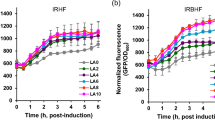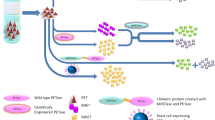Abstract
A medium-chain-length poly-3-hydroxyalkanote (MCL-PHA) depolymerase knockout mutant of Pseudomonas putida KT2440 was produced by double homologous recombination. A carbon-limited shake-flask study confirmed that depolymerase activity was eliminated. Lysis of both mutant and wild-type strains occurred under these conditions. In carbon-limited, fed-batch culture, the yield of unsaturated monomers from unsaturated substrate averaged only 0.62 mol mol−1 for the phaZ minus strain compared to 0.72 mol mol−1 for the wild type. The mutant strain also produced more CO2 and less residual biomass from the same amount of carbon substrate. However, most results indicated that elimination of PHA depolymerase activity had little impact on the overall yield of biomass and PHA.





Similar content being viewed by others
References
Arias S, Bassas-Galia M, Molinari G, Timmis KN (2013) Tight coupling of polymerization and depolymerization of polyhydroxyalkanoates ensures efficient management of carbon resources in Pseudomonas putida. Microb Biotechnol 6(5):551–563. doi:10.1111/1751-7915.12040
Bagdasarian M, Timmis KN (1982) Host-vector systems for gene cloning in Pseudomonas. Curr Topics Microbiol Immunol 96:47–67
Cai L, Yuan MQ, Liu F, Jian J, Chen GQ (2009) Enhanced production of medium-chain-length polyhydroxyalkanoates (PHA) by PHA depolymerase knockout mutant of Pseudomonas putida KT2442. Bioresour Technol 100(7):2265–2270. doi:10.1016/j.biortech.2008.11.020
Choi MH, Xu J, Rho JK, Zhao XP, Yoon SC (2010) Enhanced production of longer side chain polyhydroxyalkanoic acid with ω-aromatic group substitution in phaZ-disrupted Pseudomonas fluorescens BM07 mutant through unrelated carbon source cometabolism and salicylic acid β-oxidation inhibition. Bioresour Technol 101(12):4540–4548. doi:10.1016/j.biortech.2010.01.082
de Eugenio LI, Escapa IF, Morales V, Dinjaski N, Galán B, García JL, Prieto MA (2010) The turnover of medium-chain-length polyhydroxyalkanoates in Pseudomonas putida KT2442 and the fundamental role of PhaZ depolymerase for the metabolic balance. Environ Microbiol 12(1):207–221. doi:10.1111/j.1462-2920.2009.02061.x
de Eugenio LI, Galán B, Escapa IF, Maestro B, Sanz JM, García JL, Prieto MA (2010) The PhaD regulator controls the simultaneous expression of the pha genes involved in polyhydroxyalkanoate metabolism and turnover in Pseudomonas putida KT2442. Environ Microbiol 12(6):1591–1603. doi:10.1111/j.1462-2920.2010.02199.x
de Eugenio LI, García JL, García P, Prieto MA, Sanz JM (2008) Comparative analysis of the physiological and structural properties of a medium-chain-length polyhydroxyalkanoate depolymerase from Pseudomonas putida KT2442. Eng Life Sci 8(3):260–267. doi:10.1002/elsc.200700057
de Eugenio LI, García P, Luengo JM, Sanz JM, San Román J, García JL, Prieto MA (2007) Biochemical evidence that phaZ gene encodes a specific intracellular medium-chain-length polyhydroxyalkanoate depolymerase in Pseudomonas putida KT2442. Characterization of a paradigmatic enzyme. J Biol Chem 282(7):4951–4962. doi:10.1074/jbc.M608119200
Doi Y, Abe C (1990) Biosynthesis and characterization of a new bacterial copolyester of 3-hydroxyalkanoates and 3-hydroxy-ω-chloroalkanoate. Macromolecules 23(15):3705–3707. doi:10.1021/ma00217a027
Doi Y, Segawa A, Kawaguchi Y, Kunioka M (1990) Cyclic nature of poly(3-hydroxyalkanoate) metabolism in Alcaligenes eutrophus. FEMS Microbiol Lett 67(1–2):165–170. doi:10.1111/j.1574-6968.1990.tb13856.x
Elbahloul Y, Steinbüchel A (2009) Large-scale production of poly(3-hydroxyoctanoic acid) by Pseudomonas putida GPo1 and a simplified downstream process. Appl Environ Microbiol 75(3):643–651. doi:10.1128/AEM.01869-08
Fritzsche K, Lenz RW, Fuller RC (1990) An unusual bacterial polyester with a phenyl pendant group. Die Makromolekulare Chemie 191(8):1957–1965. doi:10.1002/macp.1990.021910821
Gross RA, DeMello C, Lenz RW, Brandl H, Fuller RC (1989) The biosynthesis and characterization of poly(β-hydroxyalkanoates) produced by Pseudomonas oleovorans. Macromolecules 22(3):1106–1115. doi:10.1021/ma00193a018
Huisman GW, Wonink E, de Koning G, Preusting H, Witholt B (1992) Synthesis of poly(3-hydroxyalkanoates) by mutant and recombinant Pseudomonas strains. Appl Microbiol Biotechnol 38(1):1–5. doi:10.1007/BF00169409
Jiang X, Ramsay JA, Ramsay BA (2006) Acetone extraction of MCL-PHA from Pseudomonas putida KT2440. J Microbiol Methods 67(2):212–219. doi:10.1016/j.mimet.2006.03.015
Kim OY, Gross RA, Hammar WJ, Newmark RA (1996) Microbial synthesis of poly(β-hydroxyalkanoates) containing fluorinated side-chain substituents. Macromolecules 29(13):4572–4581. doi:10.1021/ma960059j
Kim TK, Shin HD, Seo MC, Lee JN, Lee YH (2003) Molecular structure of PCR cloned PHA synthase genes of Pseudomonas putida KT2440 and its utilization for medium-chain-length polyhydroxyalkanoate production. J Microbiol Biotech 13(2):182–190
Kim YB, Kim DY, Rhee YH (1999) PHAs produced by Pseudomonas putida and Pseudomonas oleovorans grown with n-alkanoic acids containing aromatic groups. Macromolecules 32(19):6058–6064. doi:10.1021/ma981904w
Kim YB, Lenz RW (2001) Polyesters from microorganisms. In: Babel W, Steinbüchel A (eds) Advances in biochemical engineering/biotechnology: biopolyesters, vol 71. Springer, Berlin, Heidelberg, Germany, pp 51–79. doi:10.1007/3-540-40021-4_2
Kim YB, Lenz RW, Fuller RC (1992) Poly(β-hydroxyalkanoate) copolymers containing brominated repeating units produced by Pseudomonas oleovorans. Macromolecules 25(7):1852–1857. doi:10.1021/ma00033a002
Lageveen RG, Huisman GW, Preusting H, Ketelaar P, Eggink G, Witholt B (1988) Formation of polyesters by Pseudomonas oleovorans: effect of substrates on formation and composition of poly-(R)-3-hydroxyalkanoates and poly-(R)-3-hydroxyalkenoates. Appl Environ Microbiol 54(12):2924–2932
Lenz RW, Kim YB, Fuller RC (1992) Production of unusual bacterial polyesters by Pseudomonas oleovorans through cometabolism. FEMS Microbiol Rev 103(2–4):207–214. doi:10.1111/j.1574-6968.1992.tb05839.x
Maclean H, Ramsay J, Ramsay B (2008) Declining exponential feeding as a strategy for the high-density production of medium-chain-length poly-3-hydroxyalkanoates. Can J Chem 86:564–569
Nelson KE, Weinel C, Paulsen IT, Dodson RJ, Hilbert H, Martinsdos Santos VA, Fouts DE, Gill SR, Pop M, Holmes M et al (2002) Complete genome sequence and comparative analysis of the metabolically versatile Pseudomonas putida KT2440. Environ Microbiol 4(12):799–808. doi:10.1046/j.1462-2920.2002.00366.x
Preusting H, Nijenhuis A, Witholt B (1990) Physical characteristics of poly(3-hydroxyalkanoates) and poly(3-hydroxyalkenoates) produced by Pseudomonas oleovorans grown on aliphatic hydrocarbons. Macromolecules 23(19):4220–4224. doi:10.1021/ma00221a007
Ren Q, de Roo G, Ruth K, Witholt B, Zinn M, Thöny-Meyer L (2009) Simultaneous accumulation and degradation of polyhydroxyalkanoates: futile cycle or clever regulation? Biomacromolecules 10(4):916–922. doi:10.1021/bm801431c
Ritter H, von Spee AG (1994) Bacterial production of polyesters bearing phenoxygroups in the side chains: poly(3-hydroxy-5-phenoxypentanoate-co-3-hydroxy-9-phenoxynonanoate) from Pseudomonas oleovorans. Macromol Chem Phys 195(5):1665–1672. doi:10.1002/macp.1994.021950517
Sambrook J, David WR (2001) Molecular cloning: a laboratory manual, 3rd edn. Cold Spring Harbor Laboratory, Cold Spring Harbor
Schäfer A, Tauch A, Jäger W, Kalinowski J, Thierbach G, Pühler A (1994) Small mobilizable multi-purpose cloning vectors derived from the Escherichia coli plasmids pK18 and pK19: selection of defined deletions in the chromosome of Corynebacterium glutamicum. Gene 145(1):69–73. doi:10.1016/0378-1119(94)90324-7
Scholz C, Fuller RC, Lenz RW (1994) Production of poly(β-hydroxyalkanoates) with β-substituents containing terminal ester groups by Pseudomonas oleovorans. Macromol Chem Phys 195(4):1405–1421. doi:10.1002/macp.1994.021950424
Schweizer HP, Hoang TT (1995) An improved system for gene replacement and xylE fusion analysis in Pseudomonas aeruginosa. Gene 158(1):15–22. doi:10.1016/0378-1119(95)00055-B
Simon R, O’Connell M, Labes M, Puhler A (1986) Plasmid vector for the genetic analysis and manipulation of rhizobia and other Gram-negative bacteria. Methods Enzymol 118:640–659. doi:10.1016/0076-6879(86)18106-7
Simon R, Priefer U, Puehler A (1983) A broad host range mobilization system for in vivo genetic engineering: transposon mutagenesis in Gram-negative bacteria. Nature Biotechnol 1(9):784–791. doi:10.1038/nbt1183-784
Solaiman DKY, Ashby RD, Foglia TA (2003) Effect of inactivation of poly (hydroxyalkanoates) depolymerase gene on the properties of poly (hydroxyalkanoates) in Pseudomonas resinovorans. Appl Microbiol Biotechnol 62(5–6):536–543. doi:10.1007/s00253-003-1317-4
Sun Z, Ramsay JA, Guay M, Ramsay BA (2006) Automated feeding strategies for high-cell-density fed-batch cultivation of Pseudomonas putida KT2440. Appl Microbiol Biotechnol 71(4):423–431. doi:10.1007/s00253-005-0191-7
Sun Z, Ramsay JA, Guay M, Ramsay BA (2007) Carbon-limited fed-batch production of medium-chain-length polyhydroxyalkanoates from nonanoic acid by Pseudomonas putida KT2440. Appl Microbiol Biotechnol 74(1):69–77. doi:10.1007/s00253-006-0655-4
Sun Z, Ramsay JA, Guay M, Ramsay BA (2007) Fermentation process development for the production of medium-chain-length poly-3-hydroxyalkanoates. Appl Microbiol Biotechnol 75(3):475–485. doi:10.1007/s00253-007-0857-4
Sun Z, Ramsay JA, Guay M, Ramsay BA (2009) Fed-batch production of unsaturated medium-chain-length polyhydroxyalkanoates with controlled composition by Pseudomonas putida KT2440. Appl Microbiol Biotechnol 82(4):657–662. doi:10.1007/s00253-008-1785-7
Witholt B, Kessler B (1999) Perspectives of medium-chain-length poly(hydroxyaIkanoates), a versatile set of bacterial bioplastics. Curr Opin Biotechnol 10(3):279–285. doi:10.1016/S0958-1669(99)80049-4
Zinn M, Witholt B, Egli T (2001) Occurrence, synthesis and medical application of bacterial polyhydroxyalkanoate. Adv Drug Deliv Rev 53(1):5–21. doi:10.1016/S0169-409X(01)00218-6
Acknowledgments
The authors gratefully acknowledge the provision of plasmid pEX18Tc, pK18mobsacB and E. coli S17-1 by Professor Keith Poole at the Department of Biomedical and Molecular Sciences, Queen’s University, Kingston, Ontario, Canada, and the financial support of the Ontario Centres of Excellence.
Author information
Authors and Affiliations
Corresponding author
Rights and permissions
About this article
Cite this article
Vo, M.T., Ko, K. & Ramsay, B. Carbon-limited fed-batch production of medium-chain-length polyhydroxyalkanoates by a phaZ-knockout strain of Pseudomonas putida KT2440. J Ind Microbiol Biotechnol 42, 637–646 (2015). https://doi.org/10.1007/s10295-014-1574-5
Received:
Accepted:
Published:
Issue Date:
DOI: https://doi.org/10.1007/s10295-014-1574-5




